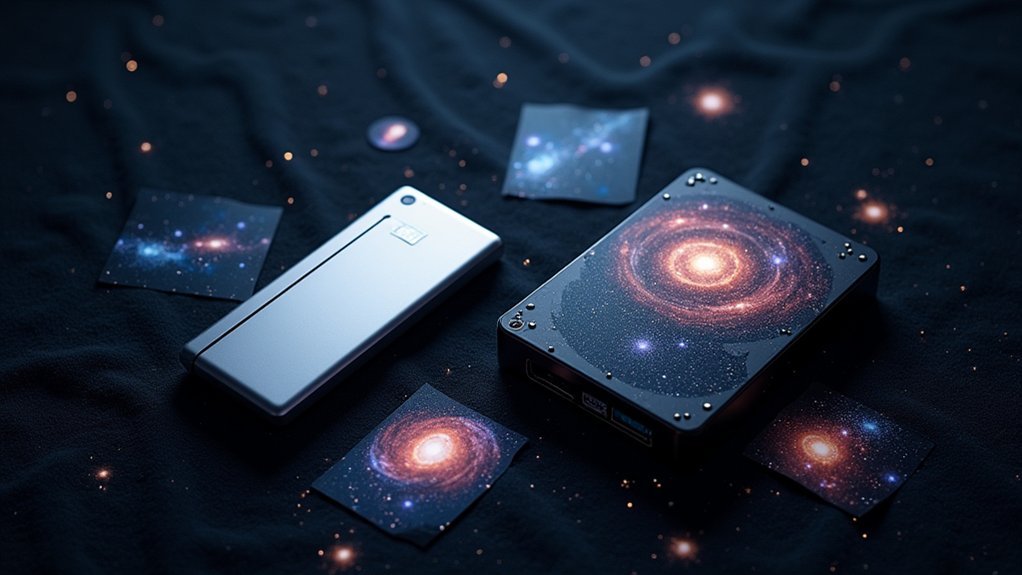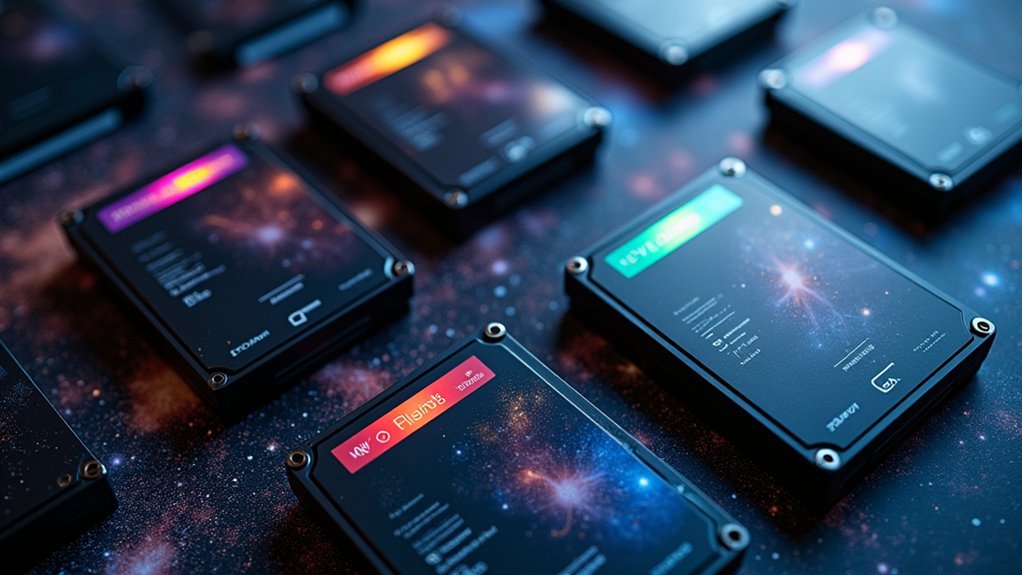For astrophotography storage, you’ll need a balance of speed and capacity. SSDs like the Samsung T7 (1050MB/s) are ideal for active projects with faster processing times, while HDDs offer economical long-term storage for completed work. Consider a tiered approach: use SSDs for current imaging sessions and HDDs for archives. External drives with USB 3.1 Gen 2 or Thunderbolt connections prevent bottlenecks. The right storage configuration can transform your imaging workflow and safeguard your celestial captures.
9 Second-Level Headings

Three essential factors shape your hard drive choice for astrophotography: speed, capacity, and reliability.
When processing image data, SSDs like the Samsung T7 deliver up to 1050MB/s read/write speeds, greatly accelerating your workflow during capture and editing sessions.
For long-term data storage, mechanical drives offer better value, providing larger capacities at lower costs.
Consider using external drives strategically—SSDs for active projects and HDDs for archiving completed work.
If you’re serious about both performance and protection, implement a RAID array using devices like the G-Technology G RAID.
This configuration balances speed with redundancy, safeguarding your valuable celestial captures.
Remember to maintain multiple copies across different drives or use cloud backup services like Backblaze to guarantee your astrophotography data remains secure.
Understanding Storage Requirements for Astrophotography Files
When you engage in astrophotography, you’ll quickly discover that file storage isn’t just an afterthought—it’s an essential component of your workflow. Your storage capacity needs are substantial, with RAW images typically ranging from 30-50MB each, and projects easily exceeding 1TB of data.
Manage your astrophotography data deliberately—when each night’s shooting generates gigabytes, storage becomes as crucial as your telescope.
- Consider investing in both SSD drives for active projects and HDDs for archival storage.
- Plan for fast data transfer speeds to reduce processing times (DSS can complete in under two hours on SSDs).
- External drives provide flexibility for expanding your storage as your image library grows.
- Implement a tiered approach: SSDs for current work, HDDs for completed projects.
- Explore cloud storage options as a backup solution for your most valuable processed images.
External SSDs vs. HDDs: Performance Comparison for Image Processing

When processing astrophotography images, you’ll notice SSDs dramatically outperform HDDs with speeds up to 3,500 MB/s versus 200 MB/s, potentially reducing your stacking time from 14 hours to under 2 hours.
You can optimize your workflow by using SSDs for active projects while archiving completed work to more cost-effective HDDs.
SSDs also offer superior reliability in varying temperature conditions during nighttime imaging sessions, as they lack the mechanical components that make HDDs vulnerable to failure.
Speed Differences Matter
Although both storage types can handle astrophotography data, the speed differences between external SSDs and HDDs greatly impact your workflow efficiency.
External SSDs deliver read/write speeds up to 3,500 MB/s compared to HDDs’ modest 30-200 MB/s, dramatically reducing your processing times. What used to take 14 hours on an HDD can be completed in just 100 minutes on an SSD.
- You’ll avoid mechanical failure risks that plague HDDs during intensive operations
- Your data management becomes more efficient with quick image access and organization
- Processing times for stacking operations decrease by up to 88%
- Your workflow maintains consistent performance during continuous use
- You’ll experience better data integrity with less risk of overheating during demanding tasks
Workflow Optimization Tips
Since your astrophotography workflow directly impacts final image quality, enhancing your data processing chain becomes vital for successful results.
When processing large image files, SSDs deliver 15-100 times faster transfer speeds than HDDs (500-3,500 MB/s versus 30-200 MB/s).
For maximum performance, keep your workflow divided: use SSDs for active processing and HDDs for long-term storage. A practical example shows the difference—image stacking that takes 14 hours on an HDD completes in just 1 hour 40 minutes on an SSD.
To maintain ideal SSD performance, keep internal drives less than 50% full. Additionally, your connection type matters greatly—use USB 3.1 Gen 2 or Thunderbolt interfaces for external drives to eliminate bottlenecks in your workflow, ensuring those impressive SSD speeds aren’t wasted during essential processing steps.
Temperature And Reliability
External SSDs and HDDs diverge greatly in their temperature management and reliability profiles during intensive astrophotography workflows.
When processing your celestial images, the thermal characteristics directly impact both performance and data integrity.
- SSDs can overheat during continuous data processing, potentially triggering throttling that slows transfer speeds.
- HDDs face mechanical limitations around 100 MB/s due to their physical spinning disks, regardless of temperature.
- Your SSD’s shock resistance offers superior reliability when transporting equipment between shooting locations.
- Temperature monitoring becomes critical for SSDs to maintain their 500-3,500 MB/s performance advantage during demanding image stacking.
- HDDs require proper ventilation to prevent reliability issues during extended processing sessions.
Consider these thermal and reliability factors when selecting storage for your astrophotography data, as they’ll greatly impact your workflow efficiency and long-term data preservation.
Top Recommended External Drives for Astronomy Imaging

Four standout options dominate the market for astrophotography data storage, each offering unique advantages for your imaging workflow.
The Samsung T7 Shield 4TB delivers impressive 1050 MB/s transfer speeds, ideal for fast data processing during active imaging sessions.
Content creators working with massive image files will appreciate G-Technology’s 12TB G RAID, which balances 500MB/s performance with substantial storage space.
For maximum capacity, the LaCie 1big Dock 16TB provides an enormous 16TB large drive, though its 280 MB/s speed might create bottlenecks during intensive capture sessions.
The Vital X6 4TB hits a sweet spot with 700MB/s speeds in a portable package, though you’ll eventually need expansion.
Consider combining SSDs for active projects with mechanical drives for archival storage to optimize your complete astrophotography workflow.
NVMe Solutions for High-Speed Stacking and Processing
Most serious astrophotographers eventually hit a processing bottleneck with conventional drives.
When handling massive amounts of data from deep-sky imaging sessions, NVMe SSDs deliver game-changing performance benefits with transfer speeds up to 3-6GB/s—exponentially faster data processing than traditional storage options.
- A dedicated 256 or 512GB NVMe SSD workspace drive dramatically reduces image stacking times
- Samsung 860 EVO SATA III 4TB SSDs offer excellent capacity-to-speed ratio for your primary storage
- NVMe drives prevent frame loss during intensive capture operations, preserving data integrity
- Consider using an external hard drive with NVMe technology for field processing capabilities
- Monitor drive temperatures consistently, as overheating can compromise performance during extended stacking sessions
Upgrading to NVMe storage might seem expensive initially, but you’ll quickly appreciate the time saved when processing hours of high-resolution celestial captures.
Building an Effective Backup Strategy for Astronomical Data

While high-performance drives accelerate your astrophotography workflow, protecting your hard-earned data remains equally important.
Implement a thorough backup strategy that includes multiple layers of protection. Consider a RAID 5 configuration for your primary storage, offering both speed and redundancy against drive failures.
Never gamble with your astrophotography data—layered backups with redundant RAID configurations are your insurance policy against digital disaster.
Schedule regular backups to an external hard drive or NAS system, with services like Backblaze providing affordable offsite options for additional security.
Monitor your storage devices using tools that track drive temperatures and SMART data to preemptively address potential failures.
For ideal data access, utilize SSDs for active processing while archiving completed projects on larger mechanical drives.
Temperature Management and Drive Reliability Under Heavy Workloads
Astrophotography processing can push your storage devices to their limits, causing temperatures to rise dramatically during extended editing sessions.
When your external drives overheat, you’ll notice significant performance degradation that can compromise your astronomical data. Continuous temperature monitoring isn’t just recommended—it’s crucial for maintaining drive reliability during intensive image stacking and processing.
- Implement proper cooling solutions to keep SSDs operating at ideal temperatures
- Use high-quality USB cables and drivers to guarantee consistent data transfer rates
- Monitor drive temperatures regularly during sustained high-workload sessions
- Consider external drives with built-in heat dissipation features for astrophotography work
- Place your drives in well-ventilated areas away from other heat-generating equipment
NAS Systems for Long-Term Astrophotography Archives

NAS systems offer critical RAID configurations that protect your valuable astrophotography data through redundancy, preventing catastrophic loss when a drive fails.
You’ll want to implement a multiple backup strategy that combines both your NAS solution and secondary archives to maximize protection against equipment failure or disaster scenarios.
While cloud storage provides off-site security, a local NAS gives you faster access to massive image libraries without subscription fees or bandwidth limitations.
RAID Configuration Benefits
The three primary benefits of RAID configurations make them ideal for storing your precious astrophotography data.
When you’re capturing the cosmos, you’ll appreciate how RAID systems distribute data across multiple drives, providing both redundancy and performance enhancements that standard external drives can’t match.
- RAID 5 offers the perfect balance of speed and data protection through striping with parity, safeguarding your images when drives fail.
- NAS systems with RAID configurations can easily exceed 20TB capacity, accommodating years of deep-sky imaging projects.
- Improved read/write speeds considerably reduce processing time for large image stacks and files.
- Automated data recovery capabilities guarantee you won’t lose valuable data if a drive fails.
- Built-in software solutions handle scheduled backups and integrity checks, maintaining your astrophotography archive without manual intervention.
Multiple Backup Strategy
Serious stargazers understand that a single backup solution isn’t enough when preserving irreplaceable night sky captures. This is where a thorough approach using NAS systems becomes invaluable.
Your NAS can serve as the cornerstone of a robust backup strategy, complementing your external drive solutions. With built-in RAID configurations like RAID 5, your data remains protected even if a drive fails.
The beauty of NAS systems lies in their versatility—they offer automated backup solutions that work silently in the background while you focus on capturing the cosmos.
As your collection grows, you’ll appreciate the expandable storage capacity NAS provides. You can easily add drives when needed.
Cloud vs. Local Storage
When deciding on a storage solution for your astrophotography collection, you’ll inevitably face the cloud versus local storage question.
Network Attached Storage (NAS) systems offer compelling advantages for serious astrophotographers. These devices provide centralized storage accessible from any device on your home network, while supporting RAID configurations that protect your valuable images from drive failures.
- NAS systems enable fast access to large image files without subscription fees
- RAID configurations provide redundancy, protecting your data when drives fail
- Built-in backup solutions automate your data protection workflow
- Multiple users can simultaneously access your astrophotography archive
- NAS storage keeps your collection organized with robust file management systems
Unlike cloud options with ongoing costs and potential bandwidth limitations, a properly configured NAS delivers superior performance while keeping your complete astrophotography archive secure and accessible.
Budget-Friendly Storage Solutions for Beginning Astrophotographers
As you begin your astrophotography journey, finding affordable storage solutions becomes vital to preserve your celestial captures without breaking the bank.
The WD My Passport offers best external hard drive value with up to 6TB for around $84, including backup software and portable design.
For faster file access, consider the Essential X6 1TB SSD at approximately $62, delivering transfer speeds up to 800MB/s.
If you need to store data economically, the Toshiba Canvio Advance 2TB ($78) provides a reliable 150MB/s performance.
Shooting in challenging environments? The SanDisk Professional G-Drive ArmorATD ($100/2TB) offers rugged protection.
For ideal workflow, combine affordable storage options—use an SSD for active projects and an HDD for long-term archiving of your cosmic images.
Frequently Asked Questions
Which Hard Disk Is Best for Data Storage?
For general data storage, you’ll want to choose based on your needs. SSDs offer speed but HDDs give more capacity for less money. Consider WD My Book for budget-friendly, high-capacity options.
Is SSD or HDD Better for Storing Photos?
For storing photos, SSDs are better for active editing with faster access speeds, while HDDs offer more affordable long-term storage. You’ll want an SSD for projects you’re working on frequently.
Is It a Good Idea to Store Photos on an External Hard Drive?
Yes, storing photos on an external hard drive is a smart choice. You’ll get cost-effective storage space, protect your internal drive from clutter, and benefit from included backup features for safeguarding your precious memories.
Is SSD or HDD Better for Long-Term Storage?
For long-term storage, HDDs are better than SSDs. You’ll benefit from HDDs’ lower cost per gigabyte and larger capacities. They’re ideal when you don’t need the speed advantages that SSDs offer for active projects.
In Summary
Whether you’re capturing deep sky objects or planetary details, you’ll need reliable storage that matches your workflow. Consider SSDs for processing speed, HDDs for cost-effective archives, and always maintain a solid backup system. Don’t skimp on quality—your hard-earned images deserve proper protection. With the right storage solution, you’ll enjoy both performance and peace of mind for years to come.





Leave a Reply